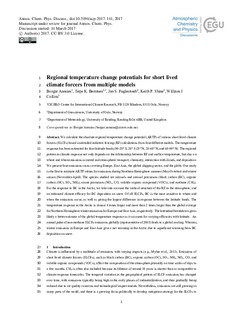| dc.description.abstract | We calculate the absolute regional temperature change potential (ARTP) of various short-lived climate forcers (SLCFs) based on detailed radiative forcing (RF) calculations from four different models. The temperature response has been estimated for four latitude bands (90–28° S, 28° S–28° N, 28–60° N, and 60–90° N). The regional pattern in climate response not only depends on the relationship between RF and surface temperature, but also on where and when emissions occurred and atmospheric transport, chemistry, interaction with clouds, and deposition. We present four emissions cases covering Europe, East Asia, the global shipping sector, and the entire globe. Our study is the first to estimate ARTP values for emissions during Northern Hemisphere summer (May–October) and winter season (November–April). The species studied are aerosols and aerosol precursors (black carbon, organic carbon, SO2, NH3), ozone precursors (NOx, CO, volatile organic compound), and methane (CH4). For the response to BC in the Arctic, we take into account the vertical structure of the RF in the atmosphere, and an enhanced climate efficacy for BC deposition on snow. Of all SLCFs, BC is the most sensitive to where and when the emissions occur, as well as giving the largest difference in response between the latitude bands. The temperature response in the Arctic per unit BC emission is almost four times larger and more than two times larger than the global average for Northern Hemisphere winter emissions for Europe and East Asia, respectively. The latitudinal breakdown likely gives a better estimate of the global temperature response as it accounts for varying efficacies with latitude. An annual pulse of non-methane SLCF emissions globally (representative of 2008) lead to a global cooling. In contrast, winter emissions in Europe and East Asia give a net warming in the Arctic due to significant warming from BC deposition on snow. | nb_NO |
